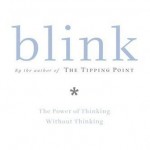I re-listened to this audio book last month. The last time I read it, I didn’t review it so I didn’t quite remember what’s all about. It’s the problem if you don’t review it after reading a book.
In the beginning, the author talked about how good we are at thin slicing. Thin slicing what most of us do naturally and sometimes less input is better than more input as we often end up confusing noise with real data. From the statistician’s perspective, too many variables can confound/confuse a person in making a decision. Cutting down the variables can help clarify things better due to correlation among the variables (independent vs. dependent). I was especially impressed with a person in the story that can call if a tennis player is about to double fault before it happens. The “lightning dating” example, in which a couple is given 6 mins to “interview” one another before being moved to the next table was also interesting; I guess this is how “table for six” comes about. The author cited the subconscious mind – gut feel or rapid cognition is very powerful. Indeed, I think some people can pick up some of the clues not known to others. Is it experience, gut feeling or six sense or telepathy? Probably all of the above.
Thin slicing can work the opposite way to hurt us, for example, Pepsi challenge. I never knew that the fault of the Pepsi challenge lies in asking if a person selects a cola based on a sip test or a gulp (whole can) test. My MBA marketing class did not drill down to this detail (or I failed to learn it). Being a sweeter formula, Pepsi would fail a gulp test but win a sip test against Coke due to its sweeter formula. There is a “duration” dimension to enjoying too much of a good thing.
Someone can also take advantage of our thin slicing and manipulate to their benefit. The use of “priming” by politicians to win our votes are a classic example – coined as the Warren Harding Effect, referring to President Warren Harding’s being elected to the Senate and the President, because he “looks like one.” President Harding ended to be one the worst presidents according to the historians.
Can an intelligent person be oblivion to this kind of “blink” skill. The author made a case that an autistic person somehow miss a part of his brain function to read the body language, thus cannot pick up the subtle cue from people. So, picking up the body language including all the tiny muscles on our face or little gesture we made allow us to make blink decision. How we translate the body language in millisecond range is probably make a difference of life and death – like Ronald Reagan’s assassination and how a few cops in a urban city can mistake pulling a wallet to be pulling a gun and shot a young immigrant to death with ten’s of bullets – all within a minute, as told by the author.
The author went to great details about what each of the facial muscles do to tell us our mood and truths. There was a lot of technical details that were hard to digest. A good cartoon animator or a good poker player can probably pick it up really fast. It’s definitely a good skill to have so you can tell if a person is lying or telling a truth.
Overall, Gladwell tells good stories. There are lots of good stories that kept the readers interested throughout the book. But the abrupt ending makes the reader wanting for more or for a grand unified theory. There is none. Like many of the reviewer in Amazon said, some people are good at thin slicing and some people are not.

